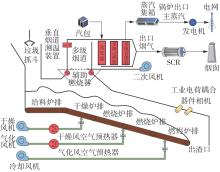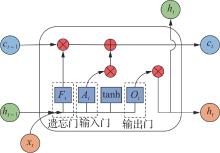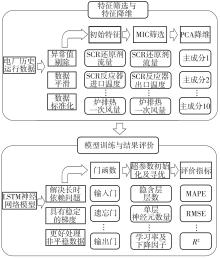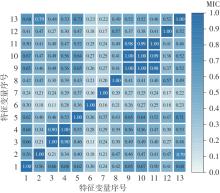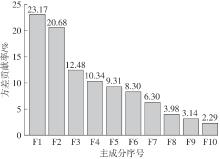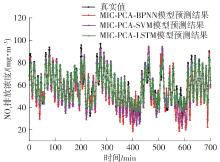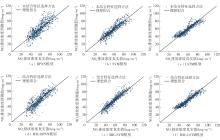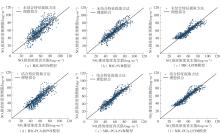Journal of South China University of Technology(Natural Science Edition) ›› 2025, Vol. 53 ›› Issue (7): 1-10.doi: 10.12141/j.issn.1000-565X.240519
• Energy, Power & Electrical Engineering • Next Articles
Emission Concentration Prediction of NO x from Waste Incinerator Based on MIC-PCA-LSTM Model
YAO Shunchun1, LI Longqian1, LIU Wen2, LI Zhenghui1, ZHOU Anli1, LI Wenjing1, CHEN Jianghong1, LU Zhimin1
- 1.School of Electric Power,South China University of Technology,Guangzhou 510640,Guangdong,China
2.Guangzhou Huantou Huacheng Environmental Protection Energy Co. ,Ltd. ,Guangzhou 510830,Guangdong,China
-
Received:2024-10-25Online:2025-07-25Published:2024-11-08 -
Contact:刘文(1983—),男,高级工程师,主要从事发电过程燃烧及其污染物排放优化控制研究。 E-mail:liuwen@gzepi.com.cn -
About author:姚顺春(1983—),男,博士,教授,主要从事能源低碳转化与清洁利用研究,E-mail: epscyao@scut.edu.cn -
Supported by:the National Key Research and Development Program of China(2024YFC3909002);the Subproject of the National Key Research and Development Program of China(2024YFC3909004-02)
CLC Number:
Cite this article
YAO Shunchun, LI Longqian, LIU Wen, LI Zhenghui, ZHOU Anli, LI Wenjing, CHEN Jianghong, LU Zhimin. Emission Concentration Prediction of NO x from Waste Incinerator Based on MIC-PCA-LSTM Model[J]. Journal of South China University of Technology(Natural Science Edition), 2025, 53(7): 1-10.
share this article
Table 1
Feature variables based on MIC screening"
| 序号 | 特征变量名称 | 单位 | 取值范围 |
|---|---|---|---|
| 1 | 空气预热器出口温度 | ℃ | 194.14~234.02 |
| 2 | SCR还原剂流量 | L/h | 1.16~65.51 |
| 3 | SCR反应器进口温度 | ℃ | 181.17~209.07 |
| 4 | SCR反应器出口温度 | ℃ | 185.73~193.89 |
| 5 | 集汽箱压力 | MPa | 6.12~6.24 |
| 6 | CO质量浓度 | mg/m3 | 0.27~47.42 |
| 7 | 炉排3左外速度 | cm/min | 20.61~112.50 |
| 8 | 炉排4右外速度 | cm/min | 3.24~82.65 |
| 9 | 二次风流量A | N·m3/h | 502.79~11 670.76 |
| 10 | 二次风流量B | N·m3/h | 180.16~12 319.38 |
| 11 | 燃尽风流量 | N·m3/h | 1 341.32~8 901.18 |
| 12 | 炉排二区左侧热一次风量 | N·m3/h | 3 725.85~8 957.53 |
| 13 | 炉排四区左侧热一次风量 | N·m3/h | 1 230.76~4 830.93 |
Table 5
Prediction performance indicators of different models with or without PCA feature extraction method"
| 模型 | MAPE/% | RMSE/(mg·m-3) | 决定系数 | 耗时/s |
|---|---|---|---|---|
| MIC-BPNN | 13.46 | 8.91 | 0.74 | 4.42 |
| MIC-PCA-BPNN | 13.27 | 8.23 | 0.75 | 4.23 |
| MIC-SVM | 8.05 | 6.04 | 0.83 | 0.87 |
| MIC-PCA-SVM | 7.63 | 5.57 | 0.86 | 0.79 |
| MIC-LSTM | 6.63 | 4.79 | 0.89 | 13.66 |
| MIC-PCA-LSTM | 6.33 | 4.71 | 0.90 | 15.91 |
| [1] | DIRIK M .Prediction of NO x emissions from gas turbines of a combined cycle power plant using an ANFIS model optimized by GA[J].Fuel,2022,321:124037/1-11. |
| [2] | 卢志民,李博航,唐雯,等 .燃煤电厂SCR脱硝系统喷氨优化模拟[J].华南理工大学学报(自然科学版),2023,51(8):62-70. |
| LU Zhimin, LI Bohang, TANG Wen,et al .Optimization simulation of ammonia injection in SCR denitrification system of coal-fired power plant[J].Journal of South China University of Technology (Natural Science Edition),2023,51(8):62-70. | |
| [3] | ADAMS D,OH D, KIM D,et al .Prediction of SO x -NO x emission from a coal-fired CFB power plant with machine learning:plant data learned by deep neural network and least square support vector machine[J].Journal of Cleaner Production,2020,270:122310/1-16. |
| [4] | LI S, MA S, WANG F .A combined NO x emission prediction model based on semi-empirical model and black box models[J].Energy,2023,264:126130/1-9. |
| [5] | ZHANG M .Characteristic-particle-tracked modeling for CFB boiler:coal combustion and ultra-low NO emission[J].Powder Technology,2020,374:632-647. |
| [6] | WANG X, LIU W, WANG Y,et al .A hybrid NO x emission prediction model based on CEEMDAN and AM-LSTM[J].Fuel,2022,310:122486/1-12. |
| [7] | LV Y, YANG T, LIU J .An adaptive least squares support vector machine model with a novel update for NO x emission prediction[J].Chemometrics and Intelligent Laboratory Systems,2015,145:103-113. |
| [8] | WANG G, AWAD O I, LIU S,et al .NO x emissions prediction based on mutual information and back propagation neural network using correlation quantitative analysis[J].Energy,2020,198:117286/1-10. |
| [9] | RADOJEVIĆ D, ANTANASIJEVIĆ D, PERIĆ-GRUJIĆ A,et al .The significance of periodic parameters for ANN modeling of daily SO2 and NO x concentrations:a case study of Belgrade,Serbia[J].Atmospheric Pollution Research,2019,10(2):621-628. |
| [10] | WANG J, FENG Y, YE S,et al .NO x emission prediction of coal-fired power units under uncertain classification of operating conditions[J].Fuel,2023,343:127840/1-11. |
| [11] | ARSIE I, CRICCHIO A, DE CESARE M,et al .Neural network models for virtual sensing of NO x emissions in automotive diesel engines with least square-based adaptation[J].Control Engineering Practice,2017,61:11-20. |
| [12] | HOCHREITER S, SCHMIDHUBER J .Long short-term memory[J].Neural Computation,1997,9(8):1735-1780. |
| [13] | LI Z, YAO S, CHEN D,et al .Multi-parameter co-optimization for NO x emissions control from waste inci-nerators based on data-driven model and improved particle swarm optimization[J].Energy,2024,306:132477/1-13. |
| [14] | TANG J, GUO Y, LI M,et al .A hybrid approach for the dynamic monitoring and forecasting of NO x emissions in power plants[J].Sustainable Energy,Grids and Networks,2023,36:101208/1-11. |
| [15] | XIAN W, WANG Z, SHI L,et al .Rapid identification of cocrystal components of explosives based on Raman spectroscopy and principal component analysis[J].Vibrational Spectroscopy,2024,132:103689/1-6. |
| [16] | PENG C, ZHENG J, CHEN T,et al .Tool wear feature extraction in BTA deep hole drilling process based on maximum probability multi-synchrosqueezing transform of spindle current signal[J].Measurement,2025,241:115780/1-14. |
| [17] | 喻成龙,黄碧纯,杨颖欣 .分子筛应用于低温NH3-SCR脱硝催化剂的研究进展[J].华南理工大学学报(自然科学版),2015,43(3):143-150. |
| YU Cheng-long, HUANG Bi-chun, YANG Ying-xin .Research progress on the application of molecular sieves in low-temperature NH3-SCR denitrification catalysts[J].Journal of South China University of Technology (Natural Science Edition),2015,43(3):143-150. | |
| [18] | CONTESSI D, VIVERIT L, PEREIRA L N,et al .Decoding the future: proposing an interpretable machine learning model for hotel occupancy forecasting using principal component analysis[J].International Journal of Hospitality Management,2024,121:103802/1-17. |
| [19] | KUMAR VYAS J, PERUMAL M, MORAMARCO T .Non-contact discharge estimation at a river site by using only the maximum surface flow velocity[J].Journal of Hydrology,2024,638:131505/1-12. |
| [1] | BI Jun, WANG Jianing, WANG Yongxing. Short-Term Operation State Prediction of Charging Station Based on LSTM-FC Model [J]. Journal of South China University of Technology(Natural Science Edition), 2025, 53(2): 58-67. |
| [2] | CHEN Tingzhao, CHEN Yanyan, WANG Zili, et al. Methods of Determining the Range of Non-motorized Travel Influence Area Under the Concept of “Metro Transit Micro-center” [J]. Journal of South China University of Technology(Natural Science Edition), 2022, 50(7): 56-65. |
| [3] | HUANG Ling, HUANG Zixu, WU Zerong, et al. Comparison of Data-Driven Human-Like Driving Models Under Different Behavior Model Frameworks [J]. Journal of South China University of Technology(Natural Science Edition), 2022, 50(10): 1-10. |
| [4] | LIANG Jingzhang, HUANG Xingshu, WU Lijuan, et al. Clustering Method of Power Load Profiles Based on KPCA and Improved K-means [J]. Journal of South China University of Technology (Natural Science Edition), 2020, 48(6): 143-150. |
| [5] | GUO Mingjun, LI Weiguang, YANG Qijiang, et al. Amplitude Filter Characteristics of PCA and Its Application in Feature Extraction of Rotor [J]. Journal of South China University of Technology (Natural Science Edition), 2020, 48(5): 125-133. |
| [6] | GUO Mingjun, LI Weiguang, YANG Qijiang, et al. PCA Feature Frequency Extraction Algorithm Based on SVD Principle and Its Application [J]. Journal of South China University of Technology(Natural Science Edition), 2020, 48(1): 1-9. |
| [7] | WANG Jian LI Hong-lei LIN Hong-fei YANG Zhi-hao ZHANG Shao-wu. Bacteria Biotope Extraction on the Basis of Neural Network [J]. Journal of South China University of Technology (Natural Science Edition), 2017, 45(3): 76-81. |
| [8] | Yu Cheng-long Huang Bi-chun Yang Ying-xin. Review on Application of Molecular Sieve to Denitration Catalysts for Low-Temperature NH3 -SCR [J]. Journal of South China University of Technology (Natural Science Edition), 2015, 43(3): 143-150. |
| [9] | Du Jian-hui Shi Yong-hua Wang Guo-rong Huang Guo-xing. Identification of Welding Seam Offset Based on PCA_RVM [J]. Journal of South China University of Technology (Natural Science Edition), 2010, 38(12): 20-23. |
| [10] | Zhong Yuan Wang Hui-nan Jiao Qing Zhang Zhi-qiang Zheng Gang Yu Hai-yan Lu Guang-ming. Effective Connectivity of Brain Network Based on Granger Causality and PCA [J]. Journal of South China University of Technology (Natural Science Edition), 2010, 38(1): 76-80. |
| [11] | Yang Jie Liu Gui-xiong . Quality Prediction and Control of Piston Rings Nitriding Based on Wavelet Transform and Elman Neural Network [J]. Journal of South China University of Technology (Natural Science Edition), 2009, 37(2): 45-48. |
| [12] | Xie Yah Wu Xiao-mei Fan Yue-ming Yu Qi-jun Huang Jian Kuang Zhuo-rong. Investigation into Incineration Bottom Ash of Municipal Solid Waste Used as Cement Admixture [J]. Journal of South China University of Technology (Natural Science Edition), 2009, 37(12): 37-43. |
| [13] | Zhang Xiao-ning Li Hong-jie Shou Yan-fang. Highway Landscape Evaluation Based on Structural Equation Modeling [J]. Journal of South China University of Technology (Natural Science Edition), 2009, 37(11): 17-21. |
| [14] | Lin Zheng-chun Wang Zhi-yan. Edge Detection Method Based on Kernel Principal Component Analysis and Subspace Classification [J]. Journal of South China University of Technology (Natural Science Edition), 2009, 37(1): 59-63. |
| [15] | Hu Li-ping Han Da-pan. Vibration-Based Damage Detection of Bridges Considering Inf1uence of Changing Environment [J]. Journal of South China University of Technology (Natural Science Edition), 2007, 35(3): 117-121. |
| Viewed | ||||||
|
Full text |
|
|||||
|
Abstract |
|
|||||
